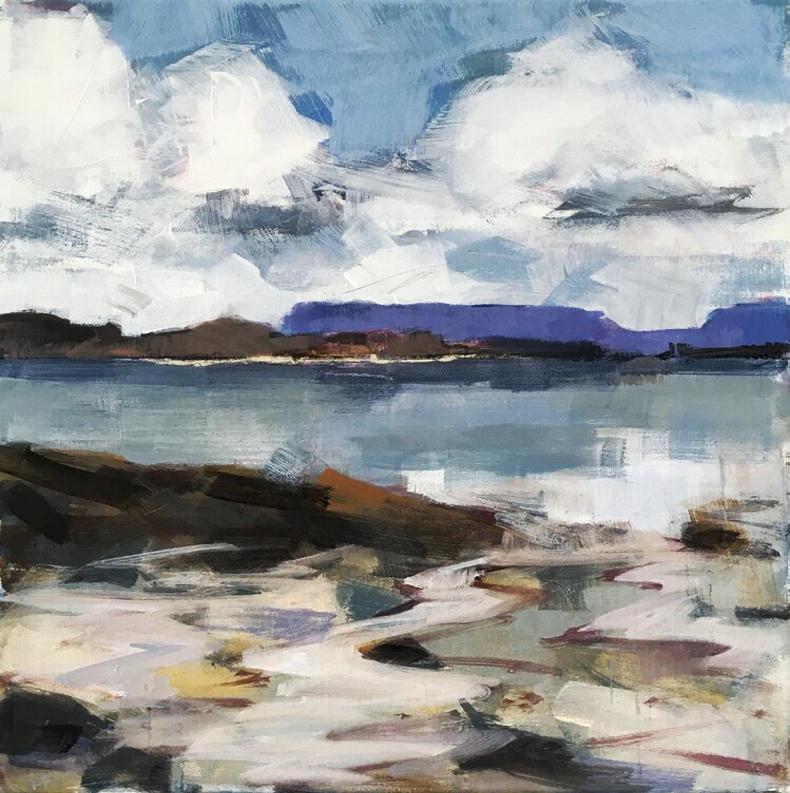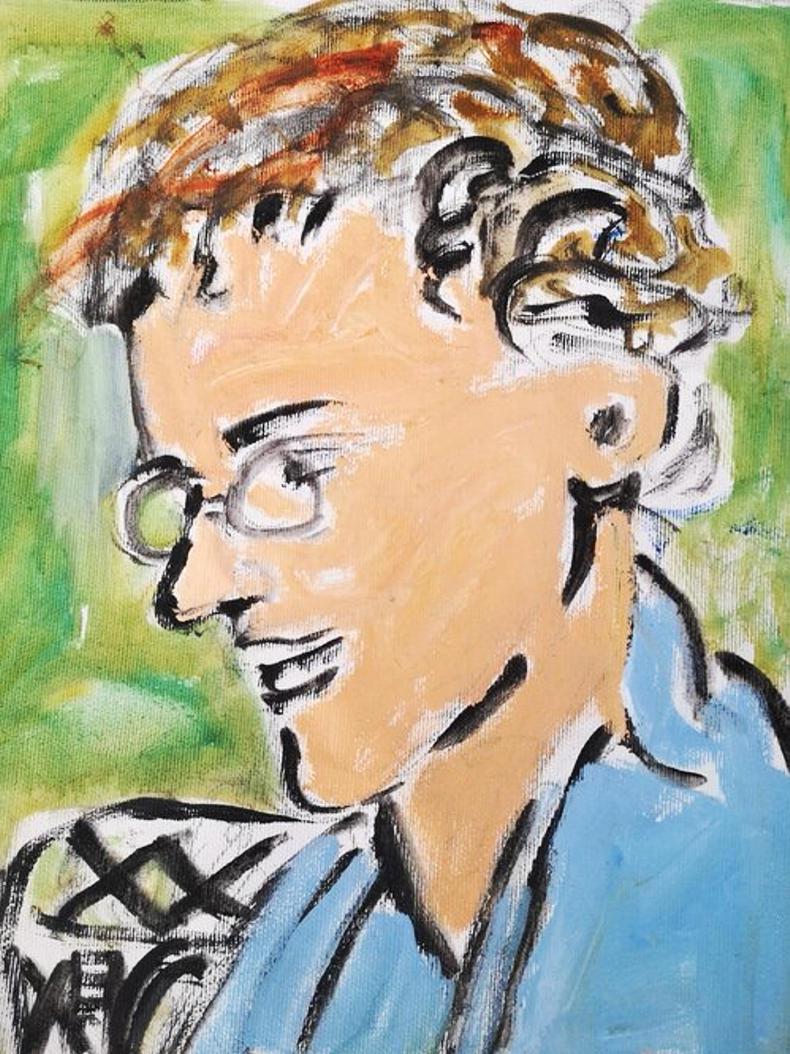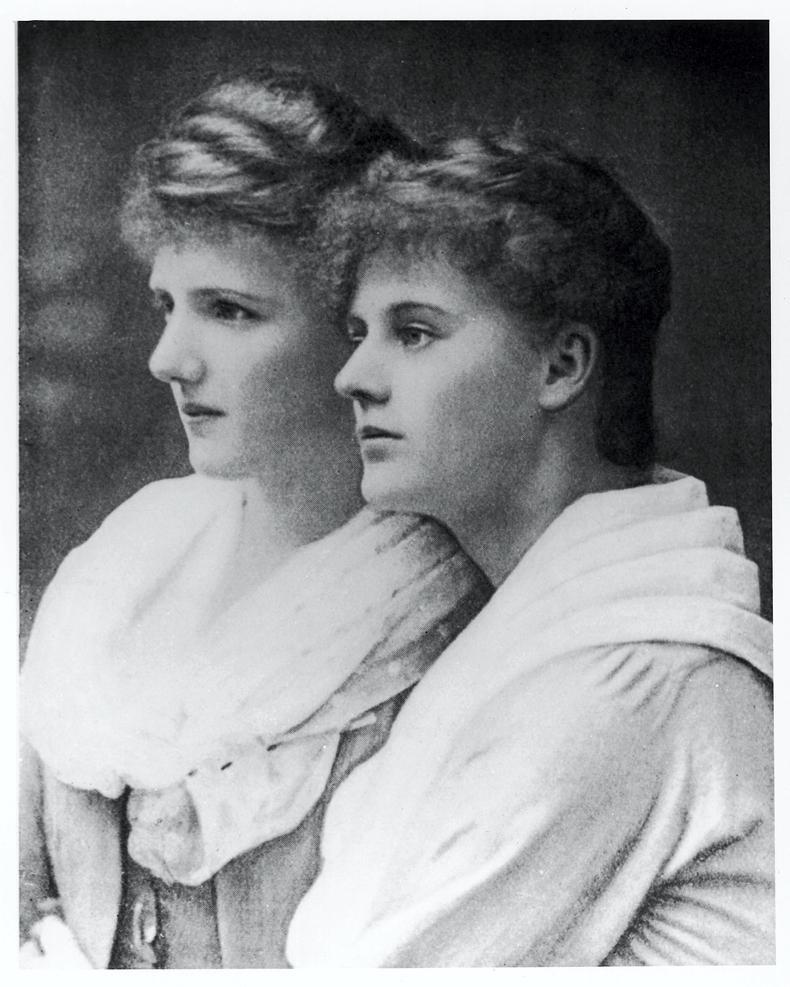I spent last weekend in Sligo, a county of great natural beauty, and most famously associated with the Yeats family. While William Butler Yeats is unquestionably the county’s favourite son, and whose brother Jack B is remembered as a great artist, one of the best-known people to be born in this western county is sometimes a little overshadowed.

Lissadell Beach by Bridget Flinn, on show at MoLI
Eva Selina Gore-Booth was born at Lissadell House 150 years ago to Sir Henry and Lady Georgina Gore-Booth. She was the third of five children born to the fifth Baronet and his wife and the first of her siblings to be born at Lissadell House. She and her siblings, who included Constance who was two years older, were the third generation of Gore-Booths at Lissadell.
Eva learned French, German, Latin and Greek and developed a love of poetry that was instilled in her by her maternal grandmother
The house today is home to Constance Cassidy, her husband Eddie Walsh and their children and the family have done much to ensure the future of Lissadell, a fitting tribute to a wonderful piece of Irish history.
We know most about Eva’s childhood thanks to one of her governesses, Miss Noel. Eva learned French, German, Latin and Greek and developed a love of poetry that was instilled in her by her maternal grandmother. She was troubled by the stark contrast between her family’s privileged life and the poverty outside the boundary walls of Lissadell, particularly during the winter of 1879 when starving tenants would come to the house begging for food and clothing.
Eva’s father was a notable Arctic explorer and, during a period of absence from the estate when Eva was just a young child, her mother established a school of needlework for women at Lissadell. The women were trained in crochet, embroidery and darning and the sale of their wares allowed them to earn a wage of 18 shillings a week.

An Aspect of Eva Gore-Booth, by Elizabeth Cope, which is part of the exhibition at MoLI
At the age of 24, Eva joined her father on his travels around North America and the West Indies
This enterprise had a great influence on Eva and her women’s suffrage and trade union work.
At the age of 24, Eva joined her father on his travels around North America and the West Indies. She kept diaries and documented their travels. On returning to Ireland she met WB Yeats for the first time. The following year, she travelled around Europe with her mother, her sister Constance who was later to become Constance Markievicz, and a friend Rachel Mansfield but, while in Venice, fell ill with a respiratory condition. In 1896, while recuperating at the villa of writer George MacDonald and his wife in Bordighera, Italy, she met Esther Roper, the English woman who would become her lifelong companion.
It is a fitting tribute to a poet and playwright, suffragist, workers’ rights campaigner, social revolutionary and pacifist
Now 93 female artists who are inspired by the life and work of Eva Gore-Booth have come together on her birthday, to provide a thematic backdrop for an exhibition of new paintings and sculpture at the Museum of Literature Ireland (MoLI) on St Stephen’s Green in Dublin. It is a fitting tribute to a poet and playwright, suffragist, workers’ rights campaigner, social revolutionary and pacifist.
The quest to shed more light on Eva Gore-Booth’s life, and draw more awareness to her legacy, has been championed by none other than President Michael D Higgins, and it was fitting that his wife Sabina opened the exhibition to coincide with St Brigid’s Day.
Speaking of Eva Gore-Booth in a keynote address in 2016, President Higgins said: “It remained of particular importance to me that adequate tribute be paid to Eva Gore-Booth as a remarkable, indeed quite extra-ordinary, figure, not just in Ireland’s Revolution, but also in the international trade union, suffrage and peace movements of the last century, and yet one, whose memory has been somewhat obscured in orthodox Irish historiography.”
The exhibition at Museum of Literature Ireland is curated by Sligo’s Hamilton Gallery and is open seven days a week until the end of March.
Read more
The Front Row: good things come in two
The Front Row: remembering another time
I spent last weekend in Sligo, a county of great natural beauty, and most famously associated with the Yeats family. While William Butler Yeats is unquestionably the county’s favourite son, and whose brother Jack B is remembered as a great artist, one of the best-known people to be born in this western county is sometimes a little overshadowed.

Lissadell Beach by Bridget Flinn, on show at MoLI
Eva Selina Gore-Booth was born at Lissadell House 150 years ago to Sir Henry and Lady Georgina Gore-Booth. She was the third of five children born to the fifth Baronet and his wife and the first of her siblings to be born at Lissadell House. She and her siblings, who included Constance who was two years older, were the third generation of Gore-Booths at Lissadell.
Eva learned French, German, Latin and Greek and developed a love of poetry that was instilled in her by her maternal grandmother
The house today is home to Constance Cassidy, her husband Eddie Walsh and their children and the family have done much to ensure the future of Lissadell, a fitting tribute to a wonderful piece of Irish history.
We know most about Eva’s childhood thanks to one of her governesses, Miss Noel. Eva learned French, German, Latin and Greek and developed a love of poetry that was instilled in her by her maternal grandmother. She was troubled by the stark contrast between her family’s privileged life and the poverty outside the boundary walls of Lissadell, particularly during the winter of 1879 when starving tenants would come to the house begging for food and clothing.
Eva’s father was a notable Arctic explorer and, during a period of absence from the estate when Eva was just a young child, her mother established a school of needlework for women at Lissadell. The women were trained in crochet, embroidery and darning and the sale of their wares allowed them to earn a wage of 18 shillings a week.

An Aspect of Eva Gore-Booth, by Elizabeth Cope, which is part of the exhibition at MoLI
At the age of 24, Eva joined her father on his travels around North America and the West Indies
This enterprise had a great influence on Eva and her women’s suffrage and trade union work.
At the age of 24, Eva joined her father on his travels around North America and the West Indies. She kept diaries and documented their travels. On returning to Ireland she met WB Yeats for the first time. The following year, she travelled around Europe with her mother, her sister Constance who was later to become Constance Markievicz, and a friend Rachel Mansfield but, while in Venice, fell ill with a respiratory condition. In 1896, while recuperating at the villa of writer George MacDonald and his wife in Bordighera, Italy, she met Esther Roper, the English woman who would become her lifelong companion.
It is a fitting tribute to a poet and playwright, suffragist, workers’ rights campaigner, social revolutionary and pacifist
Now 93 female artists who are inspired by the life and work of Eva Gore-Booth have come together on her birthday, to provide a thematic backdrop for an exhibition of new paintings and sculpture at the Museum of Literature Ireland (MoLI) on St Stephen’s Green in Dublin. It is a fitting tribute to a poet and playwright, suffragist, workers’ rights campaigner, social revolutionary and pacifist.
The quest to shed more light on Eva Gore-Booth’s life, and draw more awareness to her legacy, has been championed by none other than President Michael D Higgins, and it was fitting that his wife Sabina opened the exhibition to coincide with St Brigid’s Day.
Speaking of Eva Gore-Booth in a keynote address in 2016, President Higgins said: “It remained of particular importance to me that adequate tribute be paid to Eva Gore-Booth as a remarkable, indeed quite extra-ordinary, figure, not just in Ireland’s Revolution, but also in the international trade union, suffrage and peace movements of the last century, and yet one, whose memory has been somewhat obscured in orthodox Irish historiography.”
The exhibition at Museum of Literature Ireland is curated by Sligo’s Hamilton Gallery and is open seven days a week until the end of March.
Read more
The Front Row: good things come in two
The Front Row: remembering another time








 This is a subscriber-only article
This is a subscriber-only article





SHARING OPTIONS: